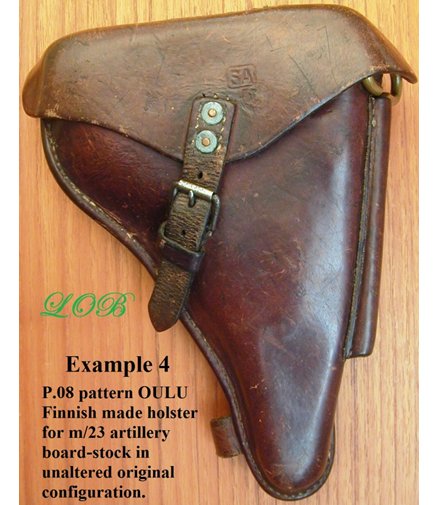buttons
The m/23 Artillery board-stock holster

The ambiguity of having an SA property stamp is not found with the m/23 board-stock Finnish and German made holsters due to their unique design with a distinctively configured back side strap harness and integral holster toe leather loop for the board-stock body and neck, being observed with and without the SA property stamp. A lot of m/23 board-stock holsters were made by OULU, identified by their trademark logo, a reindeer in a circular cartouche, stamped on the cover flap. In the 1930s, holsters received by Finnish army depots had a depot acceptance stamp located on the cover flap in the form of a circle with two canons in saltire. Some collectors believe that this stamp or logo represents a holster manufacturer other than OULU. However, since the Finnish depot logo is seen on Finnish m/23 board-stock holsters, along with the OULO trademark logo, this not the case. Pictured is one such m/23 board-stock holster of OULU manufacture with only the Finnish depot stamp that escaped or eluded the retro SA property stamp.
The m/23 board-stock holster as described by Walters in The Luger book has a particularly complicated arrangement of straps to hold it to the ex-German board-type (‘artillery’) shoulder-stocks.
Featured are four m/23 holster examples, originally made, specifically to be used with the m/23 artillery board-stock. They are identified as examples one through four, for identification in this article only, and do not represent any particular sequence or order. Three of the four examples have been modified for belt use, all modifications are different, unique to the holsters, while the fourth example is of original, unaltered configuration for use with the DWM contract provided, unused WW1 Artillery board-stock. Two of the holsters are of domestic Finnish manufacture, made by OULO, a Finnish leather maker located in OULU, Finland. The other two examples have no maker marks, resembling a commercial P.08 holster pattern and are probably of German origins.

Described are the differences in construction of the OULU made m/23 holsters vs. the German pattern m/23 holsters.
- German pattern. The holster body pull-up strap is secured to the holster body rear by stitching vs. the domestic OULU made m/23 board-stock holster which uses a rivet, although there are exceptions.
- The OULU m/23 holster uses two end-reinforcing rivets on the holster flap-to-body leather hinge strip whereas the German pattern lacks these rivets, again there are exceptions.
- The holster body steel belt buckle is larger on the OULU made m/23 board-stock holsters vs. the smaller, standard size German P.08 pattern holster body steel belt buckle.
- Based on the examples presented herein the overall size and dimensions of the OULU made m/23 board-stock holsters are slightly larger than the standard size German P.08 pattern m/23 board-stock holster.

